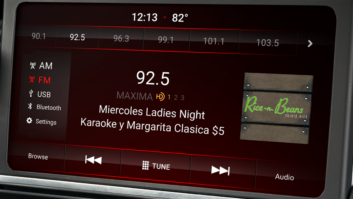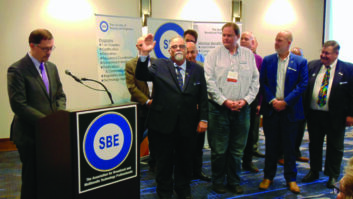CKUA Makes an Epic Move
Jun 1, 2013 10:00 AM, By Kris Rodts
Photos by Jim Dobie Photography
We didn’t set out to break any records when we moved from our 108-year-old building on Jasper Ave. in Edmonton to our new address at the restored, historical Alberta Hotel in October 2012. But after 57 years in the old building, we were bound to break something.

Main control
As it is, CKUA Radio Networks holds the record as the first educational broadcaster in Canada, dating back to 1927. We are a non-profit organization and rely on our listeners and volunteers for funding and support. The move set us up with a few firsts, including moving more than 60,000 CDs, 72,000 LPs, 11,000 78s and several hundred Edison discs that go back to 1912 — the largest vintage music library we know of in broadcasting. We estimate the entire collection consists of 1.6 million tracks, which would take about 11 years to play back to back in its entirety. We hired professionals to help us move it, and yes, we did break a few in the process. (Hint: never stack records for moving. One speed bump and the whole stack of records could crack.)
Our irreplaceable music collection was one reason why we decided to make the move — that and the Jasper building had seen better days. Through the years, we wired, rewired and patched things together as best we could, building a patchwork of studios stacked on many floors to feed 17 provincial transmitters, streaming as the public broadcaster for the Alberta province.
The old Jasper building had seen more than its share of disasters. Some years ago, a fire broke out that jeopardized the music library, the majority of which has since been digitized and now sits on 67TB of digital storage.

Studio A
Part of the reason for the move was to give our music library the kind of temperature- and moisture-controlled environment it deserved. We wanted to preserve that history, and we also needed a state-of-the-art facility, not only providing good radio programming, but the ability to showcase live performances, inviting listeners to participate.
– continued on page 2
CKUA Makes an Epic Move
Jun 1, 2013 10:00 AM, By Kris Rodts
Photos by Jim Dobie Photography
We found the perfect building that struck that balance between old and new. The Alberta Hotel is a restoration of its iconic namesake in Edmonton. The five-story building was taken apart and the original stonework was put in storage until a local architect restored the building. Our CEO Ken Regan thought it would make a great location.
We purchased the building with 50,000 square feet of open canvas, working closely with architects and consultants. We had to make some changes; for example, on the second floor we had to lower the concrete slab to accommodate the air studios.

Control 2 � backup/production and video editing suite. Looking into Main Control and Studio A
All the while we were up against the clock. The tired, old Jasper building was crumbling around us; we had one of the oldest boilers in the province, and it wasn’t a healthy building to work in, both physically and creatively.
All about workflow
We weren’t about to compromise on the layout of our new facility, though. We didn’t want to leave one layout nightmare scenario for another. In the old building, for example, our main recording Studio A was on the sixth floor, but production facilities were on the fifth. Not only did we lack visibility, but wiring throughout the facility had accumulated over the 50 years in the building. We just couldn’t make it work without a major rebuild. No amount of modern technology could make up for a patchwork workflow. The new broadcast environment has changed and required a total rethink of how things are done.

View of the News Booth showing Wheatstone”ssideboard. Looking into Control 3 (mainproduction) and Main Control 1.
For the new facility we took the time to lay out a working workflow. We also needed the right technology to make this facility as plug and play as possible. The direction in the industry — the new reality — was AoIP.
We invited two major AoIP providers to our facility for product demonstrations, and based on many factors we chose Wheatstone. We already had one of their first-ever AoIP blades as part of our iMediaTouch automation integration and a mix of Vorsis audio processors at various transmitter sites.
– continued on page 3
CKUA Makes an Epic Move
Jun 1, 2013 10:00 AM, By Kris Rodts
Photos by Jim Dobie Photography
For this move, we would become the first station to receive the new LX-24 large-format WheatNet-IP AoIP control surfaces.
As we began facility design, Wheatstone’s new LX-24 was still in development. We took one look at the surface and knew we had to have one — actually, we acquired four. A large format surface with modular fader strips, it has a large meter bridge with eyebrow metering making for great visibility. Our announcers — some of whom have been with the station since practically day one — preferred a traditional meter bridge over having another monitor in the mix. However, it is available for those who prefer more information at hand.

TOC showing Isilon Clusters, home of the digitized music lirary
This feature was not available on other consoles we initially considered, but Wheatstone obliged us. The new LX-24 was an exact fit for our combination vintage and modern facility. My millwork contractor also loved the fact that he didn’t have to cut holes in the millwork. The LX-24 is a very low-profile control surface, so it sits on the table, and your hands aren’t perched way up high to operate it.
Best of all, the LX-24 is a WheatNet-IP control surface. All controls are available on the surface, with access to almost unlimited source and destination points all connected through the WheatNet-IP Intelligent Network. We also integrated the Telos NX6 call director as part of the surfaces, making for a clean installation with one less piece of equipment cluttering the desk. We would finally be able to set up the kind of workflow and GPIO control we needed. Our system list included four LX-24s, six Audioarts IP-12 surfaces, two SideBoard surfaces and 20 some WheatNet-IP Blades (IP access nodes) tying the network together using Cisco switches. A combination of M1s and M2s were used for processing our Neumann BCM104 condenser microphones, allowing changing of settings on the fly using the GUI interface.
The tour
When it all came together, we were amazed at the workflow built into the physical, as well as the IP layered, infrastructure. Unlike the multi-floor studio layout of the old building, the main recording studio (studio A) became the center surrounded by four primary control rooms with clear sightlines to one another (main control, backup control/video editing, and two primary production suites with sharable voice booth). A news booth finishes the core. The beauty is in the flexibility an IP system gives us. Any of these rooms can be used for any purpose without re-wiring or re-configuration.

View of one of the four listening/editing suites using IP-12 surfaces.
We now not only have visibility from our four primary control rooms into Studio A, but we also have full network access and control of elements in each. From our LX-24 IP control surfaces in any room, for example, we can pull up sounders and source feeds from all over the complex, or record an interview or instrument ensemble happening in Studio A or our auditorium. Any control room can go to air, as well. That is the true beauty of an IP-based system. There are very few limitations at this point.
– continued on page 4
CKUA Makes an Epic Move
Jun 1, 2013 10:00 AM, By Kris Rodts
Photos by Jim Dobie Photography
That kind of networkable workflow extends throughout the facility. On the main floor, just off the lobby, is an auditorium seating approximately 120 people. It’s equipped with a performance stage, acoustical clouds and vaulted ceilings. Lighting trusses have been installed integral to the vaulted ceilings to accommodate lighting for video recordings. The auditorium has huge doors opening to a park next door, so when we do concerts or special events, we open the doors for overflow into the park. We encourage people to visit and be part of the experience.
The Wheatstone AoIP network allows us to broadcast live performances to air, or record them for later broadcast, really from anywhere in the facility. For larger performances, we use a Behringer X32 console. It also has IP based properties. Instead of the traditional bulky multi-wire snake, it uses a CAT-6 cable from console to stage. For broadcasts, a smaller IP-12 console is used. A Blade handles all interfaces between the two, including GPIO tally control.

Overall view of the TOC
Bulkheads are installed at key locations throughout the facility, making operations plug and play. These bulkheads are CAT-6 patch panels able to not only accommodate the AoIP network but Internet and VoIP connections. These are also color coded to avoid confusion. Red is for AoIP, white for telephone, blue for Internet, and green for anything else that might be required. All these can be patched in the TOC (technical operations center).
For special events we essentially built a control room on wheels. It has all the gear required for broadcast from anywhere in the building, including our fifth floor patio terrace overlooking the North Saskatchewan River. All that is required is one CAT-6 cable plugged into the bulkhead patch-bay and we’re on the air. Phone, laptop, automation control can also be patched in the same way. If we happen to be doing a remote broadcast for example, the audio codec or phone hybrid can be dialed up on the surface.
We worked closely with Kelly Parker, Wheatstone’s systems engineer, to set up standardized talkbacks between all studios, so any studio or control room has talkback capability. If we record out of Control Room 3, for example, we can talk to the performance center, or if we record to air, we can also talk to the performance center or Studio A — GPIO control just follows. It’s all universal. In the old Jasper building, something like this would have been a nightmare to put together, and would have required an engineer on staff to pull off. Now if there’s a Saturday performance, I no longer have to ask one of my staff to be available on his day off.
The beauty of WheatNet-IP AoIP is that announcers can dial up the equipment they need from the surface. If an announcer in a production room wants to dial up a specific microphone or other room, it’s just a matter of calling it up on the LX-24 console. WheatNet-IP is not just a routing system. That control layer in WheatNet-IP gives us control of all the elements. We can route and control through the system any of the audio codecs we use for remotes, for example. We can route and turn on/off any of the BBC satellite feeds that we need, anywhere. We have total flexibility. The WheatNet-IP has custom scripting capability, and eventually I want to use that to mirror the two primary control rooms for backup purposes. The two have GP16 panels, and we can write scripting so that if one control room fails, the other will take over automatically.
– continued on page 5
CKUA Makes an Epic Move
Jun 1, 2013 10:00 AM, By Kris Rodts
Photos by Jim Dobie Photography
Another important design consideration was the location of essential computers. Because of the networking, all computers critical to on-air operations are connected via Adderlink KVMs to TOC. This allows for monitors, mice, and keyboards to be extended to the appropriate control rooms. This lets us control the noise (computer fans), control the dust and more easily manage the computers should they develop problems or require patch around.
We also decided to go with Wheatstone AoIP audio drivers on all broadcast-related computers, including our automation play-out systems. There’s not a soundcard in the entire facility. The sound quality is astounding even to this day; there’s no A/D/A conversion, and therefore no buzzes and other noises resulting from soundcards. Essentially we are fully digital to the input of the station’s processor.
Across the hallway is a bright open work area for announcers, traffic, copy, Web and content directors (here we don’t call them program directors — it’s all about the content). Each announcer has his own work space to listen to CDs and prep his show. In addition, four multi-use editing suites are available, equipped with IP-12 consoles, Adobe Audition, CD players, turntables and phone hybrids — everything needed for phone interviews, voice tracking or just listen to CDs. Even these smaller studios could go to air if needed or provide a secondary Internet program feed.
The lower floor houses our vast music library, all temperature- and humidity-controlled and indexed for safekeeping. Currently all CDs have been digitized on 67TB (and growing) of Isilon clustered storage. The database is browser-based, owned by and custom-designed for CKUA. Through WheatNet-IP, announcers can easily access the browser (from anywhere) for songs, sounders and taglines they need for their show. They access what they want, preview, and send the results to the automation system. This kind of access is important as we don’t use music scheduling software to run the station. Announcers select what they want to play that day. This database is crucial to our operations, as we employ many contractors who provide shows to us, making this resource a critical requirement. It also allows for announcers to perform show prep from anywhere, pre-loading their selections or remote voice-tracks.
We occupy four floors in our new building, including the third that holds senior management, administration and support offices for engineering, marketing, and sales, and several board rooms. The fourth and fifth floors of the Alberta Hotel will be leased — with the exception of the fifth floor terrace, which can be used for broadcast or live performances as well. We’ve even had requests for wedding ceremonies. The views are just spectacular. Part of the main floor is also leased out and restored as the original tavern of the hotel.
Unlike the old Jasper studios, we have a central TOC that is open for viewing through glass. It really makes you realize and appreciate what is required to operate a modern broadcast facility. It’s the heart of all systems (not only broadcast) fully integrated and working as one. We use Cisco switches throughout the facility with adequate balance and redundancy. In the four primary control rooms we use smaller Cisco switches, allowing each to operate as its own island in case of complete network failure.
Remember your entire operation in essence now runs on a CAT-6 cable, which requires careful consideration, planning and layout. The best advice: First, have all network cables run, installed and terminated with each run certified by professionals. Second, invest in the best true on-line UPS you can afford. This will allow for clean power and prevent your system from re-booting during power bumps, which takes time and costs money in lost revenues.
Equipment List
Adderlink KVM
Adobe Audition
Behringer X32
Denon DN-C620
Furman PL-8 C
Henry Engineering Multiport
Middle Atlantic PD-815R-PL
Neumann BCM104, KH 120
OMT iMediaTouch
Stanton STR8.150
Torpey CLK-26
Wheatstone LX-24, IP-12, SideBoard, WheatNet Blades, GP16, M1, M2
Yellowtec Mika
Rodts is director of engineering, IT and facilities at CKUA Radio Network, Edmonton, AB.
June 2013
The 2013 Pick Hits, CKUA gets a new digital home, keep the copper safe, and Field Reports on the Rode iXY and iZoptope Insight….







